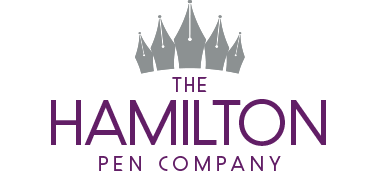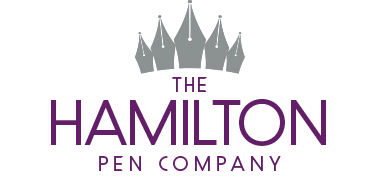A history in brief and your most popular Conklin Pens!
It has been a while since we took a look at one of the brands that we offer at The Hamilton Pen Company and with an influx of new products this month we decided it was time to take a look at the history of the Conklin Pen Company. Here at The Hamilton Pen Company we are big fans of the Conklin brand…and so are you! We will explore some of your favourite Conklin pens available at the Hamilton Pen Company.
History of The Conklin Pen Company
Our story begins in Toledo, Ohio USA with a man named Roy Conklin. The year was 1898 and Roy Conklin founded the ‘self-filling fountain pen company’ (renamed: Conklin Pen Manufacturing Co in 1901). In 1897 he filed a patent for the first working automatic filling mechanism pen, widely considered one of the world’s first self-filling fountain pens. This was the crescent filler. Although the Conklin Pen Company was officially founded in 1898, Roy Conklin, had been in the fountain pen business since 1891 and was an established innovator and inventor.The Conklin Pen Company, owing to Conklin's innovative approach, swiftly ascended in its industry, gaining prominence with its Crescent filler. The Crescent Filler was a piece of metal shaped like a crescent moon on the pen's side that, when depressed, let the ink flow into the pen. No rocket science there, just simple genius! The first models were made of hard rubber, but it was their innovative filling system that made Conklin the talk of the town. Even Mark Twain, the man with a stunner of a moustache and the creator of Huckleberry Finn and Tom Sawyer, was a fan, and even acted as their official spokesperson. In Twain's words, it was a 'profanity saver' as it couldn't roll off the desk. By 1904, Conklin decided to call it a day and sold all his shares. The golden age of Conklin followed, marked by trade expansion, vigorous promotion, and even renaming to Conklin Pen Company in 1907.

Advert from 1905. image credit: http://www.fountainpen.it/Conklin/en
In 1904, Roy Conklin withdrew from the company selling all its shares, after that the ownership passed hands several times. In this golden period Conklin followed a policy of trade expansion, with vigorous promotional campaigns, exporting even in Europe and South America and in 1907, the Conklin Pen Manufacturing Co was renamed Conklin Pen Company.
The Early 20th Century is often referred to as the golden age of fountain pens and in those early days, Conklin sat alongside the ‘Big Four’; Parker, Sheaffer, Eversharp and Waterman and was considered a ‘good’ pen brand.
Conklin, an underdog, held its own as a respectable pen brand. In 1916, Conklin came up with an ingenious spring clip that was a breeze to open. Its elegance and simplicity were so impressive that modern companies like Visconti still use a similar mechanism today. Conklin fountain pens remained a force to reckon with in the market, despite their designs seeming a tad old-fashioned. The Crescent Filler, while functional and efficient, wasn't the most appealing to the eye. However, a robust marketing campaign highlighting its virtues, featuring the renowned American author Mark Twain, kept it in the game.
But once lever filler pens hit the scene, sales started to dip, even though technically, the new mechanism was less superior. In 1921, Conklin rolled out models with a unique half-exposed lever filler mechanism. Two years later, they introduced the Duragraph model, aligning with the trend of large dimension pens started by the Parker Duofold. The Duragraph, renamed as Endura, was Conklin's bestseller, available in three versions and a range of enticing colours. Also, let's not forget Conklin's economical model tailored for students, known as the "Three Fifty", aptly named after its price in dollars. The Student was identical in shape and size to the Endura standard model, and it even came in alluring pastel hues.
In 1916, Conklin revolutionised the fountain pen industry with the introduction of an innovative spring clip mechanism that allowed for easy opening. This simple yet elegant design has stood the test of time and is still utilised by modern companies like Visconti. The only patent found for this mechanism, with patent number US-1267575, was filed in 1917.
Despite a decline in sales, Conklin fountain pens remained a major competitor in the writing instrument market. However, over time, Conklin models began to be viewed as somewhat outdated aesthetically. The Crescent Filler, while functional and efficient, was once considered unattractive from a design standpoint.
Conklin made efforts to promote the merits of their pens, including enlisting popular American author Mark Twain for advertising campaigns. Despite these efforts, the appearance of lever fill pens began to overshadow the Crescent Filler in terms of aesthetic appeal. As the writing instrument market continued to evolve, Conklin faced challenges in maintaining their competitive edge. While their innovative spring clip mechanism was a game-changer in its time, changing consumer preferences and advancements in pen design led to a shift in the industry landscape.
In 1921, Conklin revolutionised the pen industry by introducing models with a unique lever filler mechanism. This mechanism was ingeniously designed so that only half of the lever was exposed, making it both functional and aesthetically pleasing.
Two years later, in 1923, with the introduction of the large dimension pens trend started by the Parker Duofold, Conklin introduced the Duragraph model. The following year the Duragraph was renamed as Endura and the production was converted to celluloid. Initial models were in black or red hard rubber, but soon they were produced in celluloid, with different colours like Rosewood, Black & Gold, Lime Green, Lapis blue and the rare Blue & Gold present only on smaller models.
Conklin's Endura model was a standout in their lineup, being the top selling model for the company. The Endura was known for its quality construction and attention to detail, making it a popular choice among fountain pen enthusiasts. The Endura was unique in that the name was prominently displayed on both the nib and the body of the pen. This attention to branding helped establish the Endura as a premium product in the market. The Endura was produced in three main versions: a short vest pocket size, a standard size, and a senior size. Each version catered to different preferences and needs of the customers, ensuring there was a perfect Endura for everyone.

Set of Endura image credit: http://www.fountainpen.it/Conklin/en
For students or those looking for a more budget-friendly option, Conklin also produced the "Three Fifty" model. This model was heavily promoted with advertisements highlighting its affordability, hence the nickname "Three Fifty" based on its price in dollars. The Student model was similar in shape and dimension to the Endura standard model but was available in a range of pastel colours to appeal to a younger audience.
Overall, the Endura was a versatile and well-loved model by Conklin, offering a range of options to suit different preferences and budgets. Its quality construction and attention to detail made it a top choice for many fountain pen enthusiasts.

Ad for Endura 1924. image credit: http://www.fountainpen.it/Conklin/en
At that time however the company was no longer a market leader, but was merely following trends set by the other companies. An example of this is the introduction in 1929/1930 of its streamlined model, the Symetrik, following the new trend launched by the Sheaffer Balance. The sales were in constant decline and the company suffered heavily from the effects of the great recession of '29. In response to the Great Depression, Conklin released an economy line named the All-American.
In another attempt to boost sales and regain popularity, Conklin released the Nozac in 1931. Designed by Louis Vavrik, the Nozac was one of the first mass produced fountain pens equipped with a piston filler. There is some debate surrounding whether the Nozac was the first piston filler fountain pen though a piston filler created by Theodor Kovacs was patented around 1925 and later sold to Pelikan in 1927 with the ‘100’ model being released in 1929, two years before the Nozac.
The Nozac pen was known for its transparent tank, allowing users to easily see the ink level. This feature, combined with a large ink capacity, made it a practical choice for those who wrote extensively.

Ad for Nozac 1937. image credit: http://www.fountainpen.it/Conklin/en
In 1937, a new version of the Nozac pen was introduced - the One Stroke. This plunger filler model aimed to improve the efficiency and robustness of the pen's mechanism. However, despite this innovation, the Nozac still struggled to gain widespread popularity.
The Decline of Conklin
By 1938, the company was facing financial difficulties. All Conklin assets were eventually transferred to an investor group, leading to the retirement of the Endura Symetrik and Nozac pens.
During the war, the previous models of Conklin pens remained in production, but only a few pens were actually produced. The focus shifted towards other priorities during this time. In the following years, the production of Conklin pens continued to move towards the low end of the market. Economic fountain pens and low-cost ballpoint pens became the focus of the brand. Although some of these models, like the Glider, have some collectors interest, the Conklin production progressively reduced in quality and quantity, to completely cease in 1948 or 1955 - there seem to be differing accounts. A cursory glance suggests that for all intents and purposes the company ceased production in 1948 but it would be conjecture on my part to explain the 7 year difference in reports of the company’s closure.
Ultimately, Conklin was not able to keep up with competitors innovations, and although in the subsequent years after the Crescent it produced pens of undoubted value and excellent quality, still much sought by collectors, the struggle to innovate in a period of large pen companies producing exceptional writing instruments and of incredible market innovations as well as the impact of the Great Depression and Second World War played a part in the company’s decline.
The End.
But not quite!
As has happened for some other historical brands (think Blackwing as an example), Conklin was rebuilt in 2000 and operates now as Conklin Pen Co. Inc.

Its pens are essentially replicas of the successful models of the brand's golden years drawing from the original designs to create brilliant contemporary versions of Conklin's earlier vision. In 2009 the Yafa Pen Company acquired the Conklin Pen Co. and moved manufacturing and production of the higher end offerings to the Italian prestige brand Stipula. The incredibly attractive resins employed to produce the stunning reimaginings of Conklin pens results in a range of robust, attractive pens with beautiful writing characteristics and features.
Your favourite Conklin Pens at the Hamilton Pen Company
With new writing instruments from Conklin having arrived for Spring 2024, we took a look at the top 10 best selling Conklin pens at The Hamilton Pen Company…
10.Conklin All American Fountain Pen - Sunburst Orange
In the 1930s, amidst the onset of the Depression, Conklin initiated an affordable range known as the 'All American' collection. This collection, available in various sizes, filling mechanisms, and finishes, was designed to cater to an emerging market demand for high-quality, yet reasonably priced writing tools. The Conklin All American, fashioned from handmade resins, boasts a substantial size without compromising comfort during use. The cap and barrel are meticulously tapered to ensure optimal balance, demonstrating the brand's attention to detail and commitment to user comfort. The Sunburst Orange iteration of this fantastic pen is the first on our list…followed by…
9. Conklin All American Fountain Pen - Tortoiseshell
This stunning Tortie All American is a popular choice for customers of the Hamilton Pen Company - and we can see why! Tortoiseshell is a classic design and oozes stylish sophistication.
8.Conklin Minigraph Fountain Pen - Baltic Blue
The Conklin Minigraph Fountain Pen, a compact pen inspired from the popular Duragraph collection, offers a balanced and smooth writing experience due to its Conklin Cushion Point nib. It serves as an ideal travel companion and is available with a matching ballpoint pen variant. The Minigraph Fountain Pen is available in three distinct finishes - Blue Baltic (being the colour of choice for many it would seem!), Purple Dunes and White Satin. The pen utilises standard international ink cartridges and comes packaged in a sophisticated flock lined gift box, emphasising its elegance.
7.Conklin Herringbone Fountain Pen - Burgundy
The Conklin Herringbone collection introduces a remodelled barrel and accessories, merging retro charm with contemporary, striking aesthetics. The herringbone design is meticulously etched into the aerospace-grade aluminium body, followed by a layer of translucent coloured acrylic and an epoxy coating for enhanced durability. The collection offers an array of timeless finishes. The fountain pen variant is accompanied by an assortment of polished steel nib sizes, can accommodate standard international ink cartridges or an ink converter, and is encased in a plush flock lined gift box. This combination of features provides an exceptional writing experience.
6.Conklin Herringbone Ballpoint Pen - Navy Blue
Unsurprisingly, the ballpoint version of the Herringbone makes an appearance in our list - in the sleek Navy Blue tone. The herringbone pattern is meticulously carved into the body of the pen, which is crafted from aerospace-grade aluminium. This is followed by the application of a transparent coloured acrylic and a resilient epoxy coating for enhanced longevity. This ballpoint pen, available in a variety of traditional finishes, operates through a seamless twist mechanism. It is delivered in a sophisticated flock-lined gift box, adding to its appeal.
5.Conklin Duragraph Fountain Pen - Orange Nights
Introduced in 1923, the Conklin Duragraph established its reputation as a definitive pen. Its name, a fusion of 'durable' and 'graph', signifies its intention to endure for multiple generations as a cherished heirloom. The Conklin Duragraph collection modernises the classic oversized flat top design. Made from handmade resins, the Duragraph is substantial in dimensions, but remains manageable for comfortable use. The Duragraph provides an optimal selection for personalised handwriting styles, featuring Fine, Medium, or Stub nib options. It functions with standard international ink cartridges and also comes with an ink converter for those who prefer bottled ink. Each Duragraph is elegantly packaged in a satin-lined gift box.
4.Conklin Crescent Filler Fountain Pen - Vintage Green
The Conklin Crescent Filler is a fountain pen with a rich history, originating from a design by Conklin that dates back to the early 1900s. This pen became instantly recognizable due to its unique filling mechanism, which was considered innovative at the time and became a signature feature of Conklin pens. Today's Crescent Filler is manufactured from superior quality resin, incorporating the same characteristics of the original design but enhanced with the reliability of modern technology. This ensures a dependable and top-quality writing tool for users. Offering versatility, the Crescent Filler fountain pen provides options for Fine, Medium, or Stub nibs to suit different writing styles. It comes encased in a Conklin-branded gift box, making it an excellent choice for gifting to pen enthusiasts.
3.Conklin Duragraph Fountain Pen - Cracked Ice
Introduced in 1923, the Conklin Duragraph has earned a reputation as 'the definitive' pen, designed for longevity and reminiscent of the term 'durable graph'. This heirloom-quality pen is created to serve several generations. The Conklin Duragraph collection offers a contemporary approach to the classic flat top design. Constructed with superior handmade resins, the Duragraph balances size and comfort, ensuring ease of handling. Offering a selection of four distinct finishes - Amber, Cracked Ice, Forest Green, and Ice Blue - the Duragraph caters to diverse handwriting styles with its Fine, Medium, or Stub nib options. The pen accepts standard international ink cartridges and is also equipped with an ink converter for those who prefer bottled ink. It is elegantly packaged in a satin-lined gift box, enhancing its appeal as a cherished possession or a thoughtful gift.
2.Conklin All American Fountain Pen - Yellowstone
We return to the All American…this time in the design ‘yellowstone’ - it’s a stunner.
1. Conklin Duragraph Fountain Pen - Forest Green
The definitive pen sits atop the definitive position as the most popular Conklin Pen among The Hamilton Pen Company customers. The Forest Green is an exceptionally beautiful hue with a distinctive look- it's a showstopper and is very deserving of our top spot!
Explore your favourite and the full collection of Conklin today, at The Hamilton Pen Company












